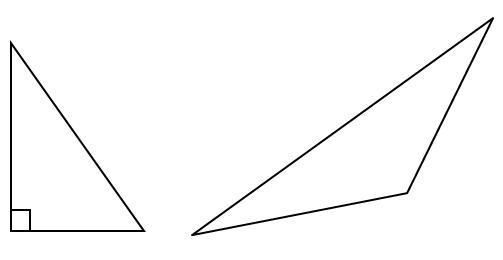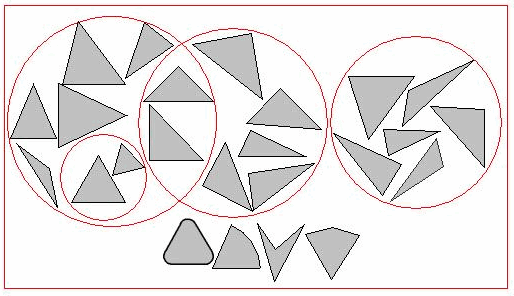Classifying Shapes: 3.5
Supporting materials
- Related Progression Points
- Developmental Overview of Space (PDF - 32Kb)
- Developmental Overview of Structure (PDF - 35Kb)
Indicator of Progress
Success depends on students being able to identify the important features of triangles and quadrilaterals (lengths and angles) and classify these shapes according to these distinguishing features.
Prior to this level, students will be able to describe features in appropriate mathematical language (e.g. identify the right angles) but will not consistently use these features to classify.
Illustration 1: Archetypal shape only
Some students are over-reliant on commonly presented examples of various shapes and do not recognise other examples. In the following diagram, students might claim that only the first shape is a triangle, and that the second shape is not a triangle. In reality, both are triangles. The first is a right-angled triangle and the second is an obtuse-angled triangle.

Illustration 2

Examples of the types of tasks that would be illustrative of shape classification skills, aligned from the Mathematics Online Interview:
- Question 55 (a – b) - Identifying triangles and explain features
- Question 58 - Triads – use ‘prototype’ or ‘properties’ strategy with cards 1, 2 and 3
Teaching Strategies
The following activities are based on resource sheets (Sheet T (Word - 58Kb) and Sheet Q (Word - 28Kb)), which each contain 24 shapes. Each sheet deliberately contains several shapes that are neither triangles nor quadrilaterals. This is to emphasise to students that triangles and quadrilaterals must have straight sides.
The focus of the activities is to use appropriate language to describe and sort these shapes. Whichever approach is used, the sorting activity should be followed up with discussion where students justify why they have placed the shapes in certain sets and subsets.
You might choose to use the full sheets and provide copies for each student or make a reusable set by printing, laminating and cutting the sheets into pieces. In this case, you might select only some of the shapes for certain activities.
Activity 1: Sorting triangles
Activity 2: Sorting Quadrilaterals
Activity 1: Sorting triangles
Students work in pairs or small groups and cut Sheet T (Word - 58Kb) along the grid lines. The shapes on this sheet are mostly triangles and can be sorted into two or more sets according to a criteria the students choose themselves, then into subsets according to other chosen criterion. Once the shapes have been sorted, they could be pasted onto A3 paper to make posters, with the sorting criteria labelled on each set and subset.
A Venn diagram could be used for displaying the subsets of triangles. The Venn diagram below shows a possible sorting of triangles and non-triangles, with the triangles sorted with isosceles in the far left circle, right-angled in the central circle (the two triangles in the intersecting region are both isosceles and right-angled) and others in the far right circle. Students at this level will be able to sort on two criteria at a time.

Possible criteria for sorting include:
- 0, 2 or 3 equal sides
- 0, 2 or 3 equal angles
- obtuse angle/no obtuse angle
- right angle/no right angle
- number of lines of symmetry (isosceles triangles have one and equilateral triangles have three)
- presence of rotational symmetry or not (equilateral triangles have one third turn symmetry)
The sorting activity should be followed up with discussion where students justify why they have placed the shapes in certain sets and subsets. Questions to discuss could include:
- Can a triangle have more than one right angle? (No)
- Can a triangle have exactly two lines of symmetry? (No)
- Can a triangle have more than one obtuse angle? (No, as the sum of the angles is 180°, there cannot be two angles larger than 90°)
- Is an equilateral triangle an isosceles triangle? (Yes)
Activity 2: Sorting quadrilaterals
Students work in pairs or small groups and cut Sheet Q (Word - 28Kb) along the grid lines. The shapes on this sheet are mostly quadrilaterals and can be sorted into two or more sets according to a criterion the students choose themselves, then into subsets according to other chosen criteria. Once the shapes have been sorted, they could be pasted onto A3 paper to make posters, with the sorting criteria labelled on each set and subset. A Venn diagram could be used for displaying the subsets of quadrilaterals. Possible criteria for sorting include:
- number of equal sides
- number of pairs of parallel sides
- number of equal angles
- number of right angles
- number of lines of symmetry (rectangles and rhombuses have two, squares have four)
- type of rotational symmetry (rectangles and parallelograms have half turn, squares have quarter turn)
The sorting activity should be followed up with discussion where students justify why they have placed the shapes in certain sets and subsets. Questions to discuss could include:
- Can a quadrilateral have only three right angles? (No, as the sum of the angles is 360°, then the fourth angle would also be 90°)
- Is a square a rhombus? (Yes, it is a special rhombus)
- Is a square a rectangle? (Yes, it is a special rectangle)
- If a square is a rhombus, is a rhombus a square? (sometimes)
- If a square is a rectangle, is a rectangle a square? (sometimes)
For a set of definitions of quadrilaterals, click here (Word - 48Kb).
For an example of a Venn diagram used to classify quadrilaterals, click here.
